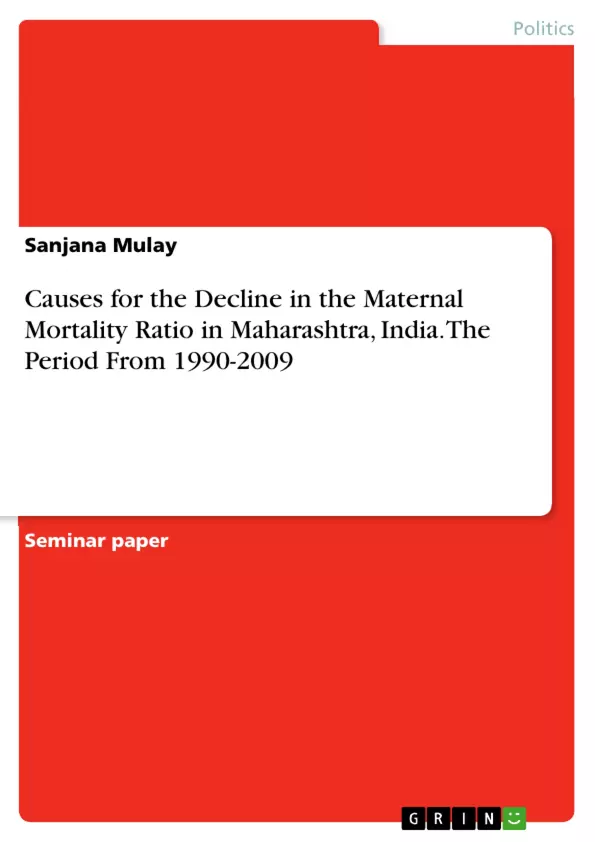India accounts for 19% of all maternal deaths globally. Maternal mortality is thus one of the most serious public health issues facing India today. During the period 1990-2009, Maharashtra’s Maternal Mortality Ratio (MMR) dropped from around 216 to 104, making it a 52% decrease in 19 years. The MMR in Maharashtra is the third lowest in the country. In 2009 Maharashtra became one of the three states (along with Tamil Nadu and Kerala) in India to have achieved the Millennium Development Goal of an MMR of 109 by the year 2015. This remarkable drop in the MMR deserves to be studied in order to identify the reasons for its occurrence and to see whether it can be replicated in the rest of the country.
Inhaltsverzeichnis (Table of Contents)
- INTRODUCTION
- OBJECTIVE
- RESEARCH QUESTIONS
- RESEARCH METHODOLOGY
- LIMITATIONS OF THE STUDY
- DEFINITIONS
- MAIN CAUSES IDENTIFIED FOR MATERNAL MORTALITY IN MAHARASHTRA
- DIRECT CAUSES
- INDIRECT CAUSES
- SOCIAL AND OTHER CORRELATES OF MATERNAL MORTALITY
- TRENDS IN THE DIRECT CAUSES AFFECTING MMR
- COMPLICATIONS DURING PREGNANCY AND DELIVERY
- MATERNAL NUTRITION
- TRENDS IN THE SOCIAL AND OTHER CORRELATES AFFECTING MMR
- PARITY
- AGE
- ACCESS TO HEALTH CARE INSTITUTIONS
- GOVERNMENT INTERVENTIONS TO IMPROVE ACCESS TO MATERNAL HEALTH CARE
- JANANI SURAKSHA YOJANA
- OTHER INTERVENTIONS
- ECONOMIC STATUS
- EDUCATION LEVELS
- CONCLUSION
- RECOMMENDATIONS
- REFERENCES
Zielsetzung und Themenschwerpunkte (Objectives and Key Themes)
The primary objective of this study is to identify the reasons behind the decline in the maternal mortality ratio (MMR) in Maharashtra during the period 1990-2009, noting the significant decrease from around 216 to 104. The study investigates the factors that influence maternal mortality in the state, analyzes their trends during the specified period, and ultimately assesses whether these trends have contributed to the observed decrease in MMR.
- Maternal mortality in India and Maharashtra
- Factors influencing maternal mortality
- Trends in maternal mortality factors
- Government interventions and their impact on maternal health care
- The role of social and economic factors in maternal mortality
Zusammenfassung der Kapitel (Chapter Summaries)
The introduction sets the context for the study by highlighting the global significance of maternal mortality, specifically in India. It then focuses on the notable decrease in Maharashtra's MMR during the period 1990-2009, underscoring the study's aim to explore the reasons behind this decline. The objective chapter states the main goal of the study, while the research questions section outlines the specific inquiries that will be addressed throughout the investigation. The research methodology chapter delves into the approach used for the study, including a literature review, factor selection, and the identification of relevant data sources. This chapter also discusses the criteria applied for selecting data sources. Chapter 5 highlights the major causes identified for maternal mortality in Maharashtra, categorizing them as direct causes, indirect causes, and social and other correlates. The subsequent chapter examines the trends observed in the direct causes affecting MMR, specifically focusing on complications during pregnancy and delivery, as well as maternal nutrition.
Schlüsselwörter (Keywords)
The research focuses on maternal mortality, maternal mortality ratio (MMR), direct and indirect causes, social and economic factors, access to healthcare institutions, government interventions, Janani Suraksha Yojana, parity, age, economic status, and education levels in the context of Maharashtra, India. The study examines the trends and impact of these factors on MMR during the period 1990-2009.
- Citation du texte
- Sanjana Mulay (Auteur), 2013, Causes for the Decline in the Maternal Mortality Ratio in Maharashtra, India. The Period From 1990-2009, Munich, GRIN Verlag, https://www.grin.com/document/1010202



